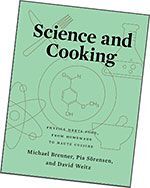A taste of soft-matter physics
DOI: 10.1063/PT.3.4726
Ten years after launching their highly successful course on science and cooking, Harvard University professors Michael Brenner, Pia Sörensen, and David Weitz have followed up with a book of the same title. It has the same objective as the course: To use cooking to teach the underlying concepts of soft-matter science.

A platter of “thousand-year-old eggs,” a traditional Chinese delicacy made by preserving quail or duck eggs in a brine made with lye, tea, and zinc.
YANGYANG FANG/SHUTTERSTOCK.COM

Although Science and Cooking: Physics Meets Food, from Homemade to Haute Cuisine is obviously of interest to physicists and chemists, its use of recipes by world-famous chefs and its focus on molecular gastronomy give the book a broader appeal. By describing the science in simple terms and adding detailed recipes, the authors have cooked up an interesting read for Physics Today’s more technically oriented audience and the general public alike.
The first three of the book’s seven chapters cover topics commonly associated with cooking: the science of food ingredients and how changing pH or temperature can induce phase transformations in food molecules. Science and Cooking’s uniqueness lies in the three subsequent chapters, which are devoted to ideas from soft-matter science, including diffusion, viscosity and elasticity, and emulsions and foams. The last chapter takes an unexpected detour and focuses on the biology and chemistry of fermentation.

The authors do an excellent job of integrating underlying topics from physics and chemistry into the book’s narrative. They discuss, for example, the structure of different types of biomolecules in food and describe how changes in temperature and pH induced by cooking cause phase transitions in those molecules. Food properties such as taste, texture, and flavor are explained in terms of the basic chemistry and related to concepts of rheology and mechanics from soft-matter physics. Diffusion and elasticity are examined in considerable detail; the former is explained using random walks, and the latter is outlined by a simple quantitative calculation.
Surprisingly, the authors did not include a simplified description of the intermolecular interactions that lead to thermal phase transitions in simple substances like water. That would have helped clarify the important distinction between the conformational phase transitions of proteins and the melting and freezing of water. The treatment of thermal physics and phase transitions in chapter 2 would have also benefited from a simplified overview of kinetic theory explaining how temperature relates to kinetic energy. In general, readers with a basic knowledge of physics and chemistry will understand and appreciate the underlying science of the topics covered in the book, but those who do not have such a background may find some of the material challenging.
The numerous recipes included in every chapter—more than a hundred in total—are a high point of Science and Cooking and serve to illustrate the scientific concepts. Many of them instruct readers on how to make simple yet delicious items, including ceviche, cheese, cookies, cakes, sauces, and beverages, that require only ingredients and tools found in most kitchens.
More exotic and complicated dishes, such as chocolate eggs, black truffle gel, and suckling pig with Riesling Pfalz, require rare ingredients and specialized equipment. However, they could be useful for restaurant chefs or demonstrations in a laboratory classroom equipped with liquid nitrogen, rotary evaporators, and temperature-controlled baths. Some of the far-out recipes like “old book essence” and “thousand-year-old eggs” are probably more fun to read than to eat, unless you have an adventurous palette.
Science and Cooking is neither a science of cooking book nor a textbook for teaching an undergraduate science and cooking course like the one taught by the authors. For those interested in learning about the physics and chemistry of cooking, there are more detailed books like On Food and Cooking: The Science and Lore of the Kitchen by Harold McGee (1984, rev. 2004), The Food Lab: Better Home Cooking Through Science by J. Kenji López-Alt (2015), and The Science of Good Cooking: Master 50 Simple Concepts to Enjoy a Lifetime of Success in the Kitchen by the editors at America’s Test Kitchen and Guy Crosby (2012).
For an undergraduate class, Science and Cooking could be complemented by the videos from the authors’ online edX course and its electronic supplement, Course Companion: For the Science and Cooking Course at Harvard (also written by Brenner, Sörensen, and Weitz), to provide a more quantitative approach to the underlying physics.
Science and Cooking provides an entertaining introduction to the fascinating science behind gastronomy and is likely to appeal to a broad audience. Those seeking to experiment with novel cooking methods and interested in analyzing recipes scientifically with the goal of improving or modifying them will find plenty to chew on here.
More about the Authors
Rama Bansil is a professor at Boston University who works on the physics of biological and synthetic gels. She has developed and taught an undergraduate course for nonscience majors on the physics of cooking based on the one at Harvard University.
Rama Bansil. Boston University, Boston, Massachusetts.
